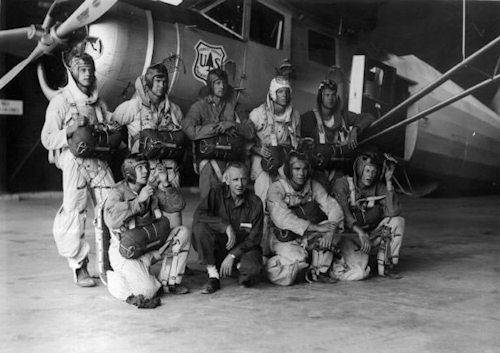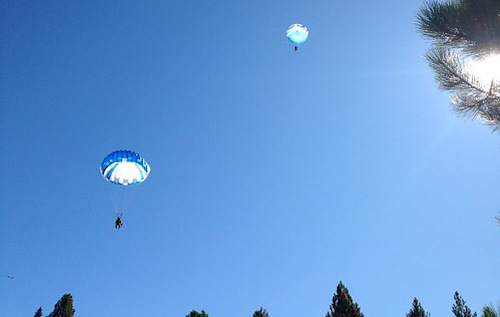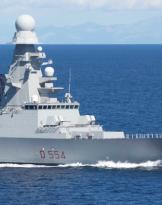Like every summer, many, too many are the fires that devastate hectares and hectares of woods. Firefighters are often supported by armed forces personnel. The last noteworthy case was that of a few weeks ago in which a team of the 9th Alpine regiment of the “Taurinense” alpine brigade intervened in Fonte Chivignano, in the territory of the Municipality of Molina Aterno (AQ). Specifically, the “Vicenza” battalion worked with a “forest fire fighting team” allowing the creation of a fire-break line essential for extinguishing the flames.
In the United States there are cd smoke jumpers or "firefighters" equipped with parachutes that can reach the most inaccessible and most dangerous areas.
In total, nine crews of paratroop firefighters operate. Seven are managed by the United States Forest Service (USFS) and two are employed by the Office of Land Management (BLM).1
- smoke jumpers they are men and women specialized in fighting ground fires by parachuting into remote and inaccessible areas and can remain completely self-sufficient even for 72 hours by creating access points for other forces in the field.
Over the years (in the following photo a team in 1948), the operations have gradually expanded and in 1981, for the first time, women2 training courses have begun.
An internship is foreseen for access to the various units. Typically, only firefighters who have proven capable both as part of a conventional fire fighting unit and crew are selected hotshot3, a small elite team of 20 of the best firefighters.

The training focuses mainly on skydiving skills and physical preparation. Physical tests consist of sit-ups, push-ups, pull-ups and ballasted 3 miles (about 5 kilometers) in 90 minutes with 110 pounds (50 kilos).
During the internship, the students carry out training packages that include obstacle course, climbing lessons, methods of parachute recovery and excavation of the line of fire. They master skydiving techniques including proper equipment care, proper aircraft exit procedures, jumping techniques, and methods for landing on rough terrain.
Given the unpredictability of wind near a fire, they learn how to use streamer to recognize the most favorable area to land safely by learning to manage the gusts encountered in mid-air.
Training is also done via a nicknamed simulator "The Mutilator". The system allows you to simulate crash landings.
The downhill suit is particularly padded and equipped with friction rings to help them get on and off the trees and are equipped with a very high collar.
If they have to reach remote places, the smoke jumpers, they carry enough food for two days so that they can concentrate on fighting the fire, rather than worrying if they will be able to replenish frequently during the effort.
If it is not necessary to parachute, they can also assist ground crews who are small in number or who need some additional technical skills.
 The first real launches were made on July 12, 1940 by Rufus Robinson (photo) of Kooskia, Idaho, and Earl Cooley of Hamilton, Montana, at Martin Creek in the Nezperce National Forest. The success has triggered rapid deployment to many of the forest services located in rural areas affected by the fires.
The first real launches were made on July 12, 1940 by Rufus Robinson (photo) of Kooskia, Idaho, and Earl Cooley of Hamilton, Montana, at Martin Creek in the Nezperce National Forest. The success has triggered rapid deployment to many of the forest services located in rural areas affected by the fires.
In 1945 the 555th Paratrooper Infantry Battalion, not being used in combat, was sent to the west coast to fight forest fires triggered by Japanese incendiary balloons. The operation was called "Operation Firefly".
The battalion, located in Oregon and California, took part in several actions against forest fires, operating more than a thousand launches and its members earned the nickname "Smokejumpers".
Major William C. Lee of the US Army, who later founded 101a airborne division, in 1940 observed the methods of the smoke jumpers at the North Cascades base to understand if and how they could be used for military purposes and later employed the techniques and ideas of the Forest Service to organize the first paratrooper training at Fort Benning, Georgia.
In addition to the skills of excellent paratroopers and effective firefighters, the smoke jumpers they must also be experts rappeller e tree climbers. In fact, it is not always possible to land in free spaces, sometimes they land on trees, so they must be in excellent physical shape to first extricate themselves and then reach the ground wearing kevlar suits and 100 pounds of equipment avoiding losing the parachute.
Once on the ground, the paratroopers turn into firefighters. They carry supplies that allow them to fight fires for up to three days: axes, chainsaws, shovels, food and drinking water. Fire fighting is done by digging 18-inch wide paths, creating lines around a fire-fighting area, delimiting the fire and the vegetation that feeds it. After a few days of uninterrupted work, the crew must reach the nearest accessible road to be picked up.
 The work doesn't finish when i "smoke jumpers" they return to base. The work simply moves on to other tasks so that the crew is prepared for the next launch: sewing torn suits, packing boxes with tools, food and water, and folding parachutes. All so that, within 2 minutes of the alarm, the operators are ready and on the plane.
The work doesn't finish when i "smoke jumpers" they return to base. The work simply moves on to other tasks so that the crew is prepared for the next launch: sewing torn suits, packing boxes with tools, food and water, and folding parachutes. All so that, within 2 minutes of the alarm, the operators are ready and on the plane.
The equipment ensures the smoke jumpers adequate protection and sufficient supply of material necessary to extinguish the flames. The jump suits are equipped with devices to facilitate the descent and work in the field. High collars protect your neck when landing in trees, multiple pockets are included to hold items like radios and cutting tools. Hook and loop fasteners around the wrists and ankles prevent injury and irritation. The helmets protect against the impact of falls, some even have front cages to avoid contact with the branches. The boots are resistant to high temperatures and are equipped with internal leather buttresses that help to walk on uneven ground. The knee pads protect the limbs during landing and the gloves prevent blistering of the hands.
- smoke jumpers they must have the essentials to keep going while they work. They are equipped with personal fire shelter that protects for a short period of time during a fast moving fire, food for two days (Gatorade, ramen, canned food), sleeping bag, axes and saws.
 Additional supplies consist of the essential emergency kit, radio /Walkie-Talkie at a distance; Additional communication tools such as light sticks, flashlights, flares, "CALL 911" flags and emergency whistles are all needed to locate mates at work and in emergencies.
Additional supplies consist of the essential emergency kit, radio /Walkie-Talkie at a distance; Additional communication tools such as light sticks, flashlights, flares, "CALL 911" flags and emergency whistles are all needed to locate mates at work and in emergencies.
The aircraft used are fixed-wing including Twin Otter, Dornier, Casa and Sherpa Shorts.
The DH-6 300 series Twin otter is a short take-off and landing (STOL) aircraft ideal for inland missions. The Twin otter it has a cruising speed of 150 knots, can accommodate eight men and related supplies and equipment within a radius of 340 nautical miles from the base of operations.
The concept of having personnel arrive directly on fires with parachutes arose from the need to reduce the time required to adequately mobilize resources in the event of fires, thus reducing the costs associated with fighting fires. The US Forest Service considered parachute jumping as early as the mid-30s. Foresters in the American Northwest had successfully started throwing equipment and food from fixed wing aircraft from overhead to ground personnel and subsequently thought of directly parachuting highly skilled and trained personnel.
- smoke jumpers they proved to be so successful that they were employed throughout areas of the continental United States as the primary resource for the initial attack. The fast response time, large payload, low cost and high safety standards of fixed-wing aircraft have ensured that paratroop firefighters remain an indispensable resource for dominating fires.
1 USFS. Northwest: the Redmond Smokejumpers in Redmond, Oregon. the North Cascades Smokejumpers in Winthrop, Washington.
Northern California: Region 5 Smokejumpers in Redding, California. Northern Rockies - Missoula Smokejumpers in Missoula, Montana. the Grangeville Smokejumpers in Grangeville, Idaho. the West Yellowstone Smokejumpers in West Yellowstone, Montana. Great Basin: the McCall Smokejumpers in McCall, Idaho.
BLM: Great Basin: the Boise Smokejumpers in Boise, Idaho. Alaska - Alaska Smokejumpers at Fort Wainwright, Alaska.
2 Deanne Shulman and Charlotte Larson
3 The crews hotshot they are elite teams of professional firefighters. They maintain high standards of excellence and are multi-skilled. The hotshot born in Southern California in the late 40s, the name comes from being in the hottest part of fires. Their specialty is fire suppression but, at times, they are assigned to other jobs, including search and rescue and disaster relief.
Photo: US Army / USFS / US Air Force












